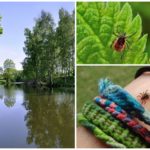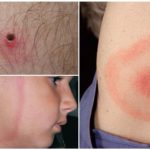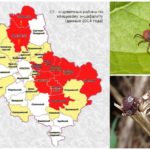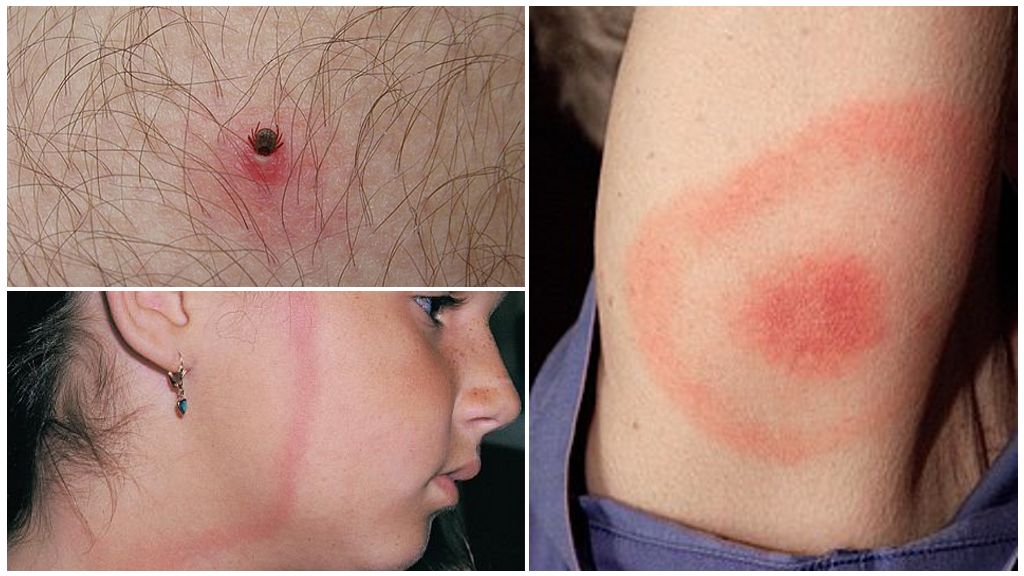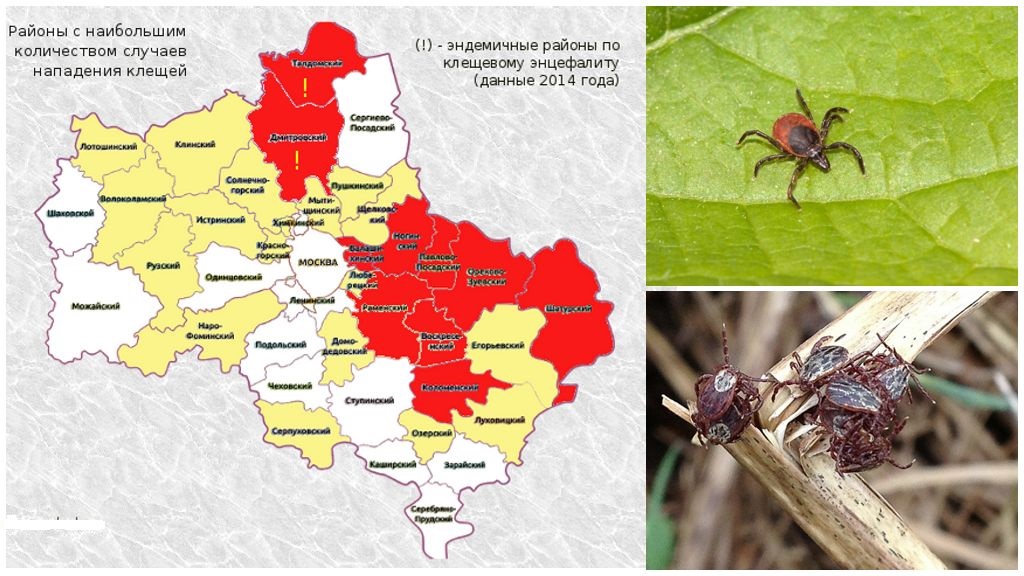Ticks in Moscow region and Moscow in 2018
Content
- Ticks in the Moscow region
- Tick-borne diseases
- Dangerous areas for ticks on the map of the Moscow region
Ticks are representatives of arachnids and begin their livelihoods after the snow melt. They winter in the fallen leaves and, waking up after hibernation, begin to immediately look for their prey. With its tenacious paws, the bloodsucker clings to a passing animal or person. Since the beginning of April, ticks in the Moscow region and Moscow in 2018 can already attack a person and infect him with a dangerous disease.
On a note!
The spread of ticks in the metropolitan area is very extensive. You can meet with the parasite in any area of Moscow and the region. This bloodsucker is difficult to confuse with the usual insect. But for confidence, you should look at the Internet photo of ticks in the suburbs. They belong to arachnids and look appropriate: a small oval body, a clearly defined head with developed jaws, four pairs of limbs. Ticks in the Moscow region are found in several species, but the most dangerous and frequently encountered of them is Ixodic. It is his bite that can cause a serious illness.
Tick season
The peak of tick activity falls on May-June, when the weather in the Moscow region and the capital is warm, but not hot. Then there is a decrease in the activity of ticks by months to the middle of summer, and the growth bitten again begins in late August - early September. The season of ticks coincides with the period of summer work, therefore gardeners and gardeners belong to the risk group.
In order to reduce the risk of being bitten in the country, sanitary and epidemiological services offer services for treating the site from ticks in the Moscow region.The cost of such a procedure depends on the area of the land plot and ranges from 1,500 to 3,000 rubles. In addition to protecting the site from bloodsuckers, you need to protect yourself. Each person should examine his body after being in the garden or in the garden for the presence of crawling or already adhering arthropods. During work on the site, it is recommended to treat the skin or clothing with special repellent mites.
Important!
A tick bite that is not a carrier of infection can cause a strong allergic reaction in a person.
Ticks in Moscow in 2018 can also meet in any park area. The prevalence of this parasite is difficult to control, so you should avoid walking on lawns, among the bushes, away from the asphalt paths. The administrative site of the capital indicates which parks are treated for ticks in Moscow. But this does not mean that there is a 100 percent certainty that these places do not pose any danger.
On a note!
You need to be careful while walking around the Izmailovsky, Bitsevsky parks, Losinoostrovsky Reserve.In the summer months, when ticks are dangerous in the Moscow region and Moscow, before going to the large forest-park zones, you need to use special means from blood suckers.
Tick-borne diseases
The bloodsucker of a subclass of arthropods is dangerous because it can be a carrier of unpleasant viruses. Ixodic ticks (Ixodoidea), which can infect with a number of serious diseases, are the most common in the Moscow and Moscow suburbs:
- Tick-borne encephalitis is a dangerous infectious disease that affects the nervous and cardiovascular systems, disrupts the functioning of internal organs. If the victim is not provided with timely assistance and treatment, the disease can cause disability or even death of the person.
- Borreliosis or Lyme disease - a disease caused by bacteria. They affect the internal organs, reduce the body's immunity. If the disease is not treated, it enters a chronic stage and can lead to irreversible consequences for human health.
- Anaplasmosis is a less dangerous disease that lowers the victim’s immunity and contributes to the development of inflammatory processes in the body.
- Ehrlichiosis is a bacterial disease that disrupts the functioning of internal organs. Often the infection is the cause of pathologies and deterioration in the quality of life of the bitten person.
All these diseases can be successfully cured, if you ask for help in the first 2-3 days after the attack of the parasite. Immediately after detecting a sucking bloodsucker on the body, you need to carefully remove it and take it to the nearest laboratory. In the metropolitan and suburban areas there are several medical centers, where they take parasites for analysis. Addresses and names of institutions for residents of Moscow:
- Center for Molecular Diagnostics FBUN Central Research Institute of Epidemiology Rospotrebnadzor - st. Novogireevskaya, 3A, phone: +7 (495) 788-00-01;
- FBUZ Federal Center for Hygiene and Epidemiology of Rospotrebnadzor - Varshavskoe Highway, 19A, phone: +7 (495) 954-01-59;
- FBUZ Center for Hygiene and Epidemiology in Moscow. Address: Grafsky Pereulok, 4, building 2, telephone: +7 (495) 687-40-47.
The most dangerous virus is tick-borne encephalitis. In the suburbs you can conduct a study on tick encephalitis in Odintsovo, Vnukovo, Mytischi, Schelkovo, Dmitrov and other cities.The largest medical institutions in the Moscow region are:
- FBUZ Center for Hygiene and Epidemiology in the Moscow Region - Moscow Region, Mytishchi, ul. Semashko, 2, telephone: +7 (495) 582-96-55;
- Institute of Poliomyelitis and Viral Encephalitis, Moscow Region, Vnukovo, pos. Moscow, phone: +7 (498) 540-90-96.
Dangerous areas on the map of the Moscow region
Every year, statistics on the number of registered tick bites and the presence of dangerous viruses in their DNA is kept on the territory of Moscow and the Moscow region. According to this information, received in September last year, no cases of tick-borne encephalitis were recorded in Moscow and the Moscow suburbs. Based on the data obtained over the past summer seasons, a list of dangerous areas was compiled on a map of ticks in the Moscow region and Moscow in 2018:
- the first places were taken by the Ramensky, Serpukhovsky, Kolomensky districts - in each of them more than 800 cases of arachnid parasites were recorded;
- in Lyubertsy, Naro-Fominsky, Dmitrovsky and Noginsky districts, the number of cases of bites exceeds 500;
- In Chekhov, Pushkin districts, in Orekhovo-Zuyevo, tick bites in 2018 are expected in an amount not exceeding 300 cases, as was the case in 2017.
On a note!
According to the data for the last summer season, among the registered 15,857 complaints of victims, about 4 thousand of them were accounted for by the bitten children. 5958 parasites were delivered to the study. The presence of borreliosis pathogens was confirmed in 15% of cases, 3.5% of ticks were infected with anaplasmosis bacteria, and the causative agents of ehrlichiosis were found in only 0.3% of the studied parasites.
The number of ticks in the Moscow region of 2018 depends on several factors. In the case of very hot and early summer, the parasites should be less active. They also do not like very rainy weather, which often happens in the summer months in the metropolitan area.
The encephalitic tick map in the Moscow region in 2018 was created based on data from previous summer seasons. Despite the absence of recorded cases of infection with encephalitis, there is a probability of the presence of infected parasites in the Dmitrovsky, Taldomsky districts, Dubna. Epidemiologists studying the question of whether there are encephalitis ticks in Moscow keep statistics for the last several years. So far no cases of infection with a dangerous infection have been recorded.
In the period of ticks, the safest areas of the Moscow region are considered to be eastern and southern by the number of victims:
- Odintsovo;
- Mozhaisk district;
- Shakhov district;
- Kashirsky district;
- Troitsk and others.
It is impossible to say for sure whether there are encephalitis ticks in the Moscow Region. The virus can be brought from other northern neighboring areas: Yaroslavl, Tver, Ivanovo. Bloodsuckers are able to overcome the distance through transport or being on the human body.
Prevention and protective measures
To reduce the risk of Muscovites and residents of the Moscow region to be bitten by a tick, parks are treated for ticks in Moscow in 2018. Specialists of sanitary and epidemiological stations are sent to squares and parks to destroy "unwanted guests" with the help of special chemicals.
On a note!
The destruction of ticks in Moscow is carried out from March to May, when they are just emerging from hibernation.
To protect yourself from being infected with encephalitis, you can use a special vaccine. Put this vaccine is necessary until the moment when there are ticks in the suburbs.The vaccine is put in two stages: the first injection is injected 2-3 months before the ticks start to bite - in November or December. Then the second vaccination is given in 1-2 months. And only after it in two weeks immunity begins to operate. The third injection is administered after 12 months, then the vaccine is repeated every three years.
The situation with ticks infected with a no less destructive infection with borreliosis is worse - there is no vaccine for infection. So that bloodsuckers could not bite a person, it is necessary to dress appropriately for a walk in a forest or a park:
- choose closed clothing with long sleeves;
- Pants in socks, blouse or shirt in pants;
- collect long hair in a ponytail or braid and put on a hat;
- wear plain, light-colored clothing that makes it easier to catch ticks.
Special acaricidal agents in the form of aerosols that scare off bloodsuckers will also help. It should be remembered that after each visit to nature, it is necessary to carefully examine the body for the presence of parasites that have adhered.

